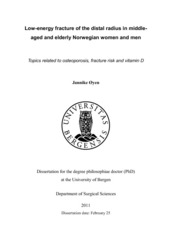| dc.contributor.author | Øyen, Jannike | en_US |
| dc.date.accessioned | 2011-05-12T11:49:14Z | |
| dc.date.available | 2011-05-12T11:49:14Z | |
| dc.date.issued | 2011-02-25 | eng |
| dc.identifier.isbn | 978-82-308-1706-3 (print version) | en_US |
| dc.identifier.uri | https://hdl.handle.net/1956/4764 | |
| dc.description.abstract | Introduction: Low-energy distal radius fractures normally occur earlier in life than hip and spine fractures and may be the first presentation of osteoporosis. Few studies have addressed the association between distal radius fracture and osteoporosis. Vitamin D inadequacy is associated with an increased risk of hip fractures, but the association with distal radius fractures has not been explored. Aims: The aims of this study were to determine the prevalence of patients with a distal radius fracture in need of osteoporosis treatment according to certain guidelines, calculate the subsequent fracture risk, and to investigate the association between distal radius fracture and osteoporosis and vitamin D inadequacy. Materials and methods: Paper I is a cross-sectional study of 1,576 female and 218 male distal radius fracture patients aged 50 years and older from Bergen, Kristiansand and Skien. Papers II and III are casecontrol studies based on the 664 female and 85 male patients from Bergen and 554 female and 54 male controls from the same area. Bone mineral density (BMD) was measured by dual energy X-ray absorptiometry (DXA). A self-administered questionnaire included information on health and lifestyle factors. A fracture risk assessment tool (FRAX®) was used to calculate the 10-year fracture risk. Serum 25-hydroxyvitamin D (s-25(OH)D) was analysed. Results: The prevalence of T-score −2.0 and −2.5 standard deviation (SD) at femoral neck was 51% and 31% in female and 38% and 20% in male distal radius fracture patients, respectively (Paper I). The 10-year FRAX® estimated hip fracture risk in all female and male patients was 9% and 6%, respectively. The corresponding figures for female and male patients with osteoporosis were 18% and 16%, respectively. A large proportion of distal radius fracture patients with a high 10-year fracture risk did not have osteoporosis. In the matched case-control study (Paper II) the prevalence of osteoporosis was 34% in female patients compared to 10% in female controls. Among men the figures were 17% and 13%, respectively. After adjustment for confounding factors by conditional logistic regression, osteoporosis was significantly associated with distal radius fractures in both women and men. The mean s-25(OH)D was 67 nmol/L in female patients and 79 nmol/L in female controls (p<0.001) (Paper III). In men the corresponding figures were 65 and 77 nmol/L (p=0.017), respectively. In adjusted conditional logistic regression analyses, s-25(OH)D < 50 nmol/L, and 50-75 nmol/L were associated with distal radius fractures in women, and s-25(OH)D < 50 nmol/L was associated with distal radius fractures in men. Conclusions: A high proportion of the distal radius fracture patients had osteoporosis compared to matched controls. However, a large proportion of the patients were not diagnosed with osteoporosis, and many of them had a high FRAX® score without having osteoporosis. Furthermore, osteoporosis and vitamin D inadequacy were associated with distal radius fractures. Thus, our results indicate that patients aged 50 years and older with a low-energy distal radius fracture should be referred to bone densitometry for measurement of BMD, and be evaluated for potential risk factors, as well as for vitamin D inadequacy. | en_US |
| dc.language.iso | eng | eng |
| dc.publisher | The University of Bergen | eng |
| dc.relation.haspart | Paper I: Osteoporosis International 21(7), Øyen, J.; Gjesdal, C. G.; Brudvik, C.; Hove, L. M.; Apalset, E. M.; Gulseth, H. C.; Haugeberg, G., Low-energy distal radius fractures in middle-aged and elderly men and women - the burden of osteoporosis and fracture risk. A study of 1794 consecutive patients, pp. 1257-1267. Copyright 2009 International Osteoporosis Foundation and National Osteoporosis Foundation. Full text not available in BORA due to publisher restrictions. The published version is available at: <a href="http://dx.doi.org/10.1007/s00198-009-1068-x" target="_blank"> http://dx.doi.org/10.1007/s00198-009-1068-x</a> | en_US |
| dc.relation.haspart | Paper II: The Journal of Bone and Joint Surgery (American) 93(4), Øyen, J.; Brudvik, C.; Gjesdal, C. G.; Tell, G. S.; Lie, S. A.; Hove, L. M., Osteoporosis as a Risk Factor for Distal Radial Fractures. A Case-Control Study, pp. 348-356. Copyright 2011 The Journal of Bone and Joint Surgery, Inc. Reproduced with permission. Published version. The published version is also available at: <a href="http://dx.doi.org/10.2106/JBJS.J.00303" target="_blank"> http://dx.doi.org/10.2106/JBJS.J.00303</a> | en_US |
| dc.relation.haspart | Paper III: Bone 48(5), Øyen, J.; Apalset, E. M.; Gjesdal, C. G.; Brudvik, C.; Lie, S. A.; Hove, L. M., Vitamin D inadequacy is associated with low-energy distal radius fractures: A case-control study, pp. 1140-1145. Copyright 2011 Elsevier. Full text not available in BORA due to publisher restrictions. The published version is available at: <a href="http://dx.doi.org/10.1016/j.bone.2011.01.021" target="_blank">http://dx.doi.org/10.1016/j.bone.2011.01.021</a> | en_US |
| dc.relation.haspart | Appendix I: Osteoporosis International 21(10), Blank, R. D.; Bilezikian, J. P.; Bonnick, S. L.; Laster, A. J.; Leib, E. S.; Lewiecki, E. M.; Miller, P. D.; Watts, N. B.; Binkley, N., “Evidence-based” or “logic-based” medicine?, pp. 1681-1683. Copyright 2010 International Osteoporosis Foundation and National Osteoporosis Foundation. Full text not available in BORA due to publisher restrictions. The published version is available at: <a href="http://dx.doi.org/10.1007/s00198-010-1269-3" target="_blank"> http://dx.doi.org/10.1007/s00198-010-1269-3</a> | en_US |
| dc.relation.haspart | Appendix II: Osteoporosis International 21(10), Øyen, J.; Gjesdal, C. G.; Brudvik, C.; Hove, L. M.; Apalset, E. M.; Gulseth, H. C.; Haugeberg, G., “Evidence-based” or “logic-based” medicine?: response to Blank et al., pp. 1685-1686. Copyright 2010 International Osteoporosis Foundation and National Osteoporosis Foundation. Full text not available in BORA due to publisher restrictions. The published version is available at: <a href="http://dx.doi.org/10.1007/s00198-010-1257-7" target="_blank"> http://dx.doi.org/10.1007/s00198-010-1257-7</a> | en_US |
| dc.subject | Osteoporosis | eng |
| dc.subject | Wrist Injuries | eng |
| dc.subject | Fractures | eng |
| dc.title | Low-energy fracture of the distal radius in middleaged and elderly Norwegian women and men. Topics related to osteoporosis, fracture risk and vitamin D | en_US |
| dc.type | Doctoral thesis | |
| dc.rights.holder | Copyright the author. All rights reserved | |
| dc.rights.holder | The author | |
| dc.subject.nsi | VDP::Medical disciplines: 700::Clinical medical disciplines: 750::Orthopedic surgery: 784 | eng |


